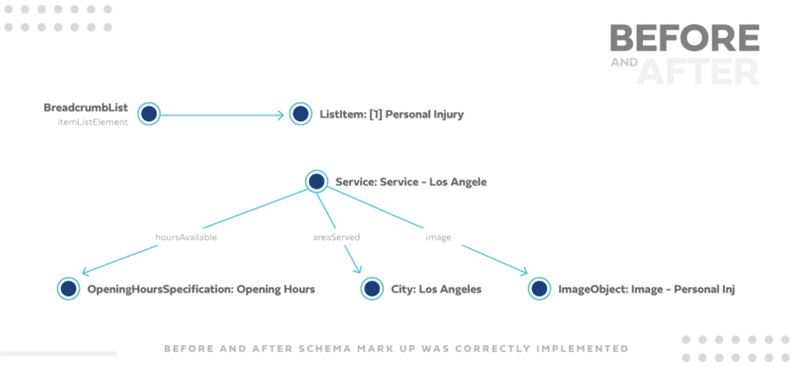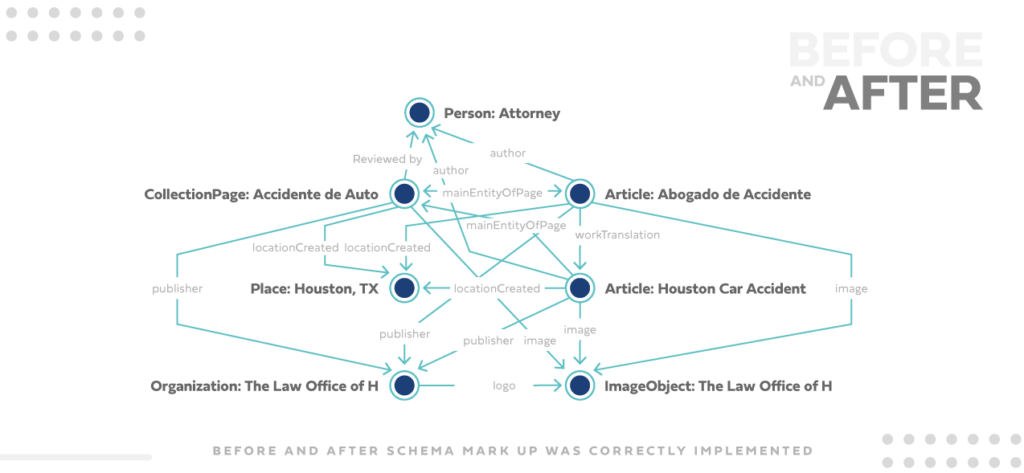Technical SEO for Lawyers
What is Technical SEO?
Technical SEO for lawyers refers to actions you take to optimize your website and server that help search engine spiders crawl and index your site, organically improving your online rankings.Part of the technical part of SEO is following the most recent algorithm changes and how they impact your Law Firms placing in the organic search engine result pages.
We will go over the most important optimizations you need to make to your law firm’s website for it to have the best chances of ranking in today’s competitive organic search market.

Important Google Algorithm Updates

Google Released their BERT (Bidirectional Encoder Representations from Transformers) algorithm in 2019, which at the time they called it “one of the biggest leaps forward in the history of Search.” This update helped Search engines better understand the intent behind users’ search queries by using neural networks (pattern recognition algorithm) along with question + answering models to fulfill a majority of queries.
The BERT Algorithm update set up the grounds for MUM. MUM is built on the same Transformer architecture model as BERT, but it is 1,000 times more powerful! This Algorithm update is closer to AI than anything Google had released before. Google says that MUM is also:
“trained across 75 different languages and many different tasks at once, allowing it to develop a more comprehensive understanding of information and world knowledge than previous models. And MUM is multimodal, so it understands information across text and images and, in the future, can expand to more modalities like video and audio.”
MUM helps Google search fully understand the content provided on a given webpage, therefore it knows how to deliver the best content for a user’s query.
Website & Server Security

Build Your Law Firm’s Website with a CMS
A content management system (CMS) is computer software that helps businesses create and manage their digital content. The exact functions of each CMS vary, but many allow you to build your website through the software.
We personally recommend WordPress, but others are available too. WordPress provides several benefits to lawyers with regard to website design and more. You don’t need coding knowledge to build a website for your law firm. WordPress makes it easy because they have tons of great plugins that add powerful functionality to your site. You will find loads of tutorials, articles, and other resources available to guide you as you use the platform. You will also find no shortage of attractive, inexpensive themes for your site.
If you are even somewhat tech-savvy, you can likely set up a website on your own. It’s easy to add and update content because WordPress is a stable CMS. Don’t let the technical talk scare you away. WordPress is user-friendly and often referred to as the gold standard among these types of platforms.

Keeping Your Website Secure with an SSL Certificate
With the occurrence of regular security breaches online, keeping your website secure is of the utmost importance. Google takes extra measures to ensure the safety of its users. They want to be a trusted search engine that only lists secure websites in their SERPs, so they strongly encourage users to implement an SSL certificate on their websites.
An SSL certificate is a collection of small pieces of data that encrypts your website’s data when you attach it. The certificate provides authentication for a website, secures data transfers, and enables an encrypted connection. Additionally, an SSL certificate protects your information, including logins, passwords, transactions, and general personal information.
What You Need to Install an SSL Certificate
To complete the integration of an SSL certification on your website, you will need:
- Access to your website server
- A purchased SSL certificate
Integrating an SSL certificate into your website is a fairly straightforward process. However, you do need to take care when purchasing one. Costs for an SSL certificate range from next to nothing to thousands of dollars per year. Not all certificates are the same or provide the same level of security. In fact, you can choose from the following three types of SSL certificates:
- Domain-validated (DV) certificates are free or really cheap. They are great for internal projects, but not the best choice for the open web. It’s likely you will collect client information on your firm’s “contact us” page, so it’s best to avoid DV certificates for your website.
- Organization-validated (OV) certificates typically are the best entry-level option for businesses, including law firms. Organizations that validate certificates already have been authenticated at some level with a governing body, making it easy to verify their legitimacy.
- Extended Validation (EV) certificates are the most trusted level of SSL certificates. Guidelines for EV certificates are thorough and strict. You will have to provide proof of identity and the location of your business to be verified. These certificates are more expensive but worth the investment to protect your data and client information from hackers.
You should also know that DV and OV certificates have two options. One is a certificate for a single domain, such as yourlawfirm.com. Single-domain certificates typically are cheaper. The other option, commonly referred to as a wildcard certificate, allows you to protect sub-domains. This is useful for law firms with multiple offices, each with its own domain. These tend to be more expensive. If you choose an EV certification, you must get a single-domain certificate because of the added security measures. You will have to buy multiple certificates to cover each domain you have.
You can buy an SSL certificate from many places, but it’s best to go with one of the major players. Google and the world trust some issuers more than others. You can find a cheap certificate, but you will likely have to take additional steps to get your law firm recognized. This can create issues for those who visit your webpage, ultimately causing them to find another law firm. Take the time to shop around, but keep in mind that you get what you pay for.
We recommend purchasing an SSL certificate from one of these reputable companies:
- Symantec
- Go Daddy
- Network Solutions
- Entrust Data Card
- Digicert
- Global Sign
Steps to Request and Install an SSL Certificate
The steps to install an SSL certificate on your website vary based on your platform or operating system. However, the general process is similar.
- Request Your SSL Certificate
- Verify Your SSL Certificate
- Download Your Certificate
- Install Your Certificate
If you choose, you can get into the nuts and bolts of manually installing your certificate. However, it’s easier and less stressful to use other tools to help. If you use WordPress to build your website, the easiest way to install an SSL certificate is to activate one of their plugins—Really Simple SSL. Once you purchase an SSL Certificate and enable Really Simple SSL, it only takes one click to install and set up your certificate.
Behind the scenes, Really Simple SSL redirects all incoming requests from http: to https:, changes your URL, fixes all insecure content on your site, and sets secure cookies for visitors. From a visual perspective, the biggest change that occurs when you add a certificate to your website is the difference in your URL protocol.
Instead of your URL beginning with http:, it will begin with https:. This makes your website safe in Google’s eyes, and you increase your chances of converting visitors to clients because users will remain on your site when they see it is secure.
CPanel Security
The Cpanel of your website is a web hosting control panel software, or web host manager. You do not only want to have a strong password for your login, but you will also want to set a strong and different password from the login, for all of your files inside your file manager.
In order to keep your law firm’s website, you need to make sure no one other than the people you have already given permission to log into your Cpanel. This can be viewed inside the File Manager part of the Cpanel, by looking at the “lastlogin” file. Make sure you can recognize the IPs listed.
Pro tip: Make a list of the IPs of the people who have access to your Cpanel. This can be easily done by Typing “what’s my IP” in Google Search which will provide you with your current IP. Make sure the FTP login has been disabled so that the data is more reliable for the user’s logins.
Google Tracking Tools
You cannot engage in beneficial SEO practices for lawyers that improve your online presence without knowing how your website is performing. Google provides a powerful suite of free tools for website owners to provide insights about website performance. We provide a broad overview of many of them below.
Google Analytics
Google Analytics is a staple for website performance tracking. It tells you everything you need to know about your users and how they interact with your website. Once you integrate Google Analytics to your law firm’s website, you can analyze metrics such as page views, sessions, average time on page, bounce rate, and much more.
Integrating Google Analytics to Your Website
Setting up Google Analytics for your law firm’s website is an easy process that only takes a few minutes. Follow these steps:
- Visit Google Analytics and create an account. If you already have an account head to the Admin portion of the platform.
- If you have WordPress, you can use a Google Analytics plugin to set it up on your website. With other platforms, you need to acquire your Google Analytics UA code snippet.
- Add the UA code there or use Google Tag Manager.
Google Search Console
Google Search Console is another one of Google’s free products that you can use for SEO purposes. It gives you the ability to monitor and optimize your website’s page rankings, impressions, click-through ratio (CTR), and more as it relates to Google Search results. Google Search Console helps you understand and optimize by focusing specifically on Google as a search engine with powerful tools and insights that improve visibility and help increase your website’s presence on SERPs. When it comes to optimizing organic traffic that comes to your website and increasing your presence and visibility, you won’t find a better tool than Search Console.
Google Search Console allows you to see which queries bring traffic to your law firm’s website. When you have information about how users find your website online, you can optimize several things to organically improve your SERP rankings. Let’s go over a few of Google Search Console’s tools that help improve how your law firm’s site is indexed:
Performance
Here you will find your website’s organic performance displayed by the queries users input to find your law firm’s content pages. This section provides information such as rankings for specific keywords, and your number of impressions, number of clicks, and CTR for each of those keywords.
URL Inspection
The URL Inspection tool shows any errors you have with your website. For example, you can see if you have errors in Accelerated Mobile Pages (AMPs). The URL Inspection tool also shows structure and indexing errors in the Schema Markup and data about Google’s indexed version of a specific page. This tool is especially useful when you want to ensure Google indexed the correct or most recent version of a page on your law firm’s website.
Coverage
Google recommends that those with at least 500 pages on their website to review the coverage report. The report shows the index status of all pages that Google spiders attempted to crawl on your site. The results of the report are grouped by status and reason. For each page, you will see one of the following messages:
- Valid. This message indicates that the page has been indexed.
- Warning. Your page is indexed, but you need to be aware of one or more issues.
- Excluded. The coverage report displays this message when Google believes you intentionally excluded a page from indexing, often indicated by a “no-index” designation.
- Error. When you have an error message on the coverage report, the page is not indexed. These are the issues you should focus on immediately. A 404 error, such as “File not found” or “Page not found,” is the most common reason Google does not index a page.
You should not expect 100 percent of your pages to be indexed at one time. However, you can use the report to fix any errors and issues that show up, naturally increasing your chances for better rankings.
Sitemaps
A sitemap is a file that shows the structure of your website. It shows information about each page and the relationships between pages. You typically think of a sitemap as a tool for users to find something on your website, but Google reads these files to crawl websites. Sitemaps tell Google the importance of files in your website and provide information such as when the page was last updated and how frequently you change the page. When you submit your sitemap in Google Search Console, you can instruct Google on which pages to crawl.
Removals
The Removal tool is used to remove pages of your site from Google search temporarily. If you have a URL that needs to be removed quickly, this is the tool to use. When you use the tool, Google will remove the page from their results and also erase their cached version of your page for around six months.
Pro Tip: Abstain from using this tool frequently, so you don’t accidentally remove something you intended to keep. Remember to be careful when using this tool.
Core Web Vitals
Core web vitals are a set of metrics that quantify elements that make up the user experience on your site and each one of your pages. They’re there to ensure only websites that have both great content and a great user experience rank in top positions, which, in turn, makes sure that: Ranking websites are more likely to have qualified traffic and, hence, convert visitors.
The search engine’s reputation as a reliable information provider is preserved.
- Ranking websites are more likely to have qualified traffic and, hence, converting visitors.
- The search engine’s reputation as a reliable information provider is preserved.
Specifically, the newest Google core web vitals update revolves around the new SEO ranking factors that focus on:
- How quickly the page loads
- Whether buttons or text move about on the page while it’s loading
- How quickly the user can interact with the page upon landing on it.
How to Install Google Search Console
Installing Google Search Console is similar to installing Google Analytics. You will either have to add a code snippet to your site’s child theme or use Google Tag Manager to integrate the code into your law firm’s website. You can also add a TXT record at the DNS level of the domain. The easiest option could be using your Google Analytics Account to create your Google Search Console. If you take this route, you don’t have to worry about implementing a code snippet to integrate Google Search Console into your website.
The installation is simple. You need to sign up for Search Console and enter your domain or URL. The search console shows information that only the site owner should have access to, so Google will prompt you to prove you are the owner of your site. Once you complete these steps, you will have access to the information and reports we discussed above once analytics has enough time to process data.
Make Your Site Mobile-Friendly

We mentioned the popularity of mobile searches in a previous chapter. Consumers and clients demand mobile-friendly websites. If a potential client gets frustrated while visiting your website, they are sure to go to your competitor’s site. This not only means your site needs to run well on a laptop and desktop, but it needs to run well on mobile devices.
You no longer have the simple luxury of only having a desktop version. As of 2021, almost three billion of the world’s internet searchers are on smartphones, representing more than half of all mobile searches worldwide. Additionally, about four billion people have smartphones, meaning some will eventually begin to use them for internet searches. Having a mobile-friendly site is a need for all businesses, including law firms.
Google Search Console’s Mobile-Friendly Test will let you know if your website is mobile-friendly, and it’s free!
Type in your URL and run the test. You’ll quickly find out if your website is mobile-friendly and will also be able to open a mobile usability report. Follow Google’s recommendations, make the necessary changes and hire a web developer, if needed, to make sure your site is mobile-friendly. More importantly, make sure your site is responsive so that your site visitors are able to view your law firm’s website on any platform.
Speed Up Your Law Firm’s Website
The length of time a user has to wait for a web page to load is among the most important technical optimizations you can make to your site. Speed plays an important part in Google’s ranking algorithm.
You can use Google’s PageSpeed Insights tool to find out how quickly the web pages on your site load. When you enter your URL, Google will provide a list of opportunities to tackle to speed up your page.
Optimizing the speed of your website will likely require the help of a web developer. You can do simple things like reducing the sizes of images and files on your site, but they will only help a little.
Pro Tip: Inside WordPress, go-to media and choose which image to edit. When you scale images, never make them wider than your page. Most pages are below 800 pixels wide, going over that is just increasing your loading times, if your page is not as wide as your image. In most cases, you can find the help you need from your hosting provider. Contact them to see if they have this kind of support available to customers.

Schema Markup (Structured Data)
Schema.org is a vocabulary that was created by Google, Microsoft, Yahoo, and Yandex. Structured data is machine-readable while HTML is only readable by humans. Google recommends using JSON-LD but they also accept Microdata and RDFa.
The web is primarily made up of unstructured data (text on a website, individual PDF documents, etc). By implementing structured data into your website you are disambiguating the information, making it easier for search engines to know exactly what the content is about. This is why we recommend adding structured data to as many pages as applicable.

There are even Microdata and other Schema specific to attorneys. Lawyers can insert schema manually into their HTML or use a handy markup generator. Google provides a data highlighter within Google Webmaster Tools which requires no knowledge of code at all.
Pro Tip: Google, as mention earlier uses schema Mark-up or Structure Data, to better understand the relation between different aspects of your law firm. Its name, structured data, refers to data that needs to be interconnected in order for search engines to receive a full image and explain to bots what your organization and content are all about. Avoid creating data islands of information that are not connected in any way to your other structured data. Not taking the time to build a schema mark-up strategy could be the difference between search engines understanding what you want to portrait.
For example, below you will find a before and after of a lawyer’s schema mark up before and after it optimized.

Notice how interconnected all schema classes are, this makes sure that search engines understand the relation between your entity, organization, services, geographic information, ratings, and much more.
Rich Snippets By Structured Data
Rich snippets displayed by the use of structured data are rich results in search engine results pages and listings on Google. These rich snippets take a larger portion of the SERPs “real estate” and can include visual elements like:
- Sitelinks
- Headings
- Stars Ratings
- Reviews
- Carousels
- F.A.Qs
- Articles
- Products & Services
Going back to our example in chapter one where we compared SEO and PPC to real estate. Adding Schema markup to pages is like increasing the size of your real estate for free. Information pushed by schema will be visible and take out more space in the SERP pages, making your organic ad more visible.


What’s Next?
You’ve now learned about some of the most difficult aspects of SEO for lawyers—technical SEO—so give yourself a pat on the back. In the next chapter, we take a closer look at on-site and on-page optimizations you can make to organically increase your Google ranking for your law firm’s website.





